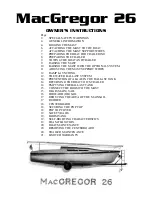
RIDING THE VEHICLE
If a higher than safe speed is reached,
slow down by braking but apply the
brake with frequent light pressure.
Never jam the brake and lock the track.
Side Hill
When crossing a side hill or travers-
ing up or downhill, certain procedures
must be followed. All riders should
lean towards the slope as required for
stability. The preferred operating po-
sitions are the kneeling position, with
the knee of the down hill leg on the
seat and the foot of the uphill leg on
the running board, or the posting posi-
tion. Be prepared to shift your weight
quickly as needed. Side hills and steep
slopes are not recommended for a be-
ginner or a novice snowmobiler.
Avalanche Hazard
When riding on mountainous terrain,
you should be aware of the risk of
avalanches. Avalanches vary in size
and shapes and generally occur in
steep terrain and on unstable snow.
New snow, animals, people, wind
and
snowmobiles
can
all
trigger
an avalanche.
Avoid high marking
or
traversing
steep
terrain
when
avalanche conditions are possible.
When in unstable snow conditions,
travel should be restricted to lower
angle slopes. Wind formed cornices
should be avoided. Staying off un-
stable conditions is the key to safe
mountain riding. Probably most impor-
tant is to be aware of the conditions
and dangers on a daily basis when in
the mountains. Check local avalanche
forecasts and threats each day before
heading out to ride and heed forecast-
ers advice.
You should always carry a snow shovel,
probe and avalanche beacon while rid-
ing on mountains. We recommend
that all mountain riders take a lo-
cal avalanche safety training course
to become more familiar with snow
conditions and learn how to properly
use their equipment.
Here are some web sites that can help
you finding important information:
– US:
www.avalanche.org
– Europe:
www.avalanches.org
– Canada:
www.avalanche.ca
Slush
Slush should be avoided at all times.
Always check for slush before starting
across any lake or river. If dark spots
appear in your tracks, get off the ice
immediately. Ice and water can be
thrown rearward into the path of a fol-
lowing snowmobile. Getting a vehicle
out of a slush area is strenuous and in
some cases, impossible.
Fog or Whiteout Conditions
On land or water,
fog or visibil-
ity-limiting snow can form. If you have
to proceed into the fog or heavy snow,
do so slowly with your lights on and
watch intently for hazards. If you are
not sure of your way, do not proceed.
Keep a safe distance behind other
snowmobilers to improve visibility and
reaction time.
Unfamiliar Territory
Whenever you enter an area that is
new to you, drive with extreme cau-
tion. Go slow enough to recognize
potential hazards such as fences or
fence posts, brooks crossing your
path, rocks, sudden dips, guy wires
and countless other obstacles which
could result in a termination of your
snowmobile ride.
Even when fol-
lowing existing tracks, be cautious.
Travel at a speed so you can see what
is around the next bend or over the top
of the hill.
Bright Sunshine
Bright sunny days can considerably
reduce your vision. The glare from
sun and snow may blind you to the ex-
tent that you cannot easily distinguish
________
SAFETY INFORMATION
________
19
Summary of Contents for Skandic Series 2016
Page 9: ...SAFETY INFORMATION ________ SAFETY INFORMATION ________ 7...
Page 39: ...VEHICLE INFORMATION _______________ 37...
Page 78: ...VEHICLE TRANSPORTATION This page is intentionally blank 76 ______________...
Page 79: ...MAINTENANCE _______________ 77...
Page 87: ...MAINTENANCE SCHEDULE EVERY 5 YEARS Replace engine coolant _______________ 85...
Page 111: ...TECHNICAL INFORMATION ______________ 109...
Page 126: ...SPECIFICATIONS This page is intentionally blank 124 ______________...
Page 127: ...TROUBLESHOOTING ______________ 125...
Page 133: ...WARRANTY ______________ 131...
Page 150: ...This page is intentionally blank 148 ______________...
Page 151: ...CUSTOMER INFORMATION ______________ 149...
Page 154: ...CHANGE OF ADDRESS OWNERSHIP This page is intentionally blank 152 ______________...
Page 155: ...CHANGE OF ADDRESS OWNERSHIP ______________ 153...
Page 156: ...CHANGE OF ADDRESS OWNERSHIP This page is intentionally blank 154 ______________...
Page 157: ...CHANGE OF ADDRESS OWNERSHIP NOTES ______________ 155...
Page 158: ...CHANGE OF ADDRESS OWNERSHIP NOTES 156 ______________...
Page 159: ...CHANGE OF ADDRESS OWNERSHIP NOTES ______________ 157...
Page 160: ...CHANGE OF ADDRESS OWNERSHIP NOTES 158 ______________...
Page 161: ...CHANGE OF ADDRESS OWNERSHIP NOTES ______________ 159...
Page 162: ...CHANGE OF ADDRESS OWNERSHIP NOTES 160 ______________...
















































